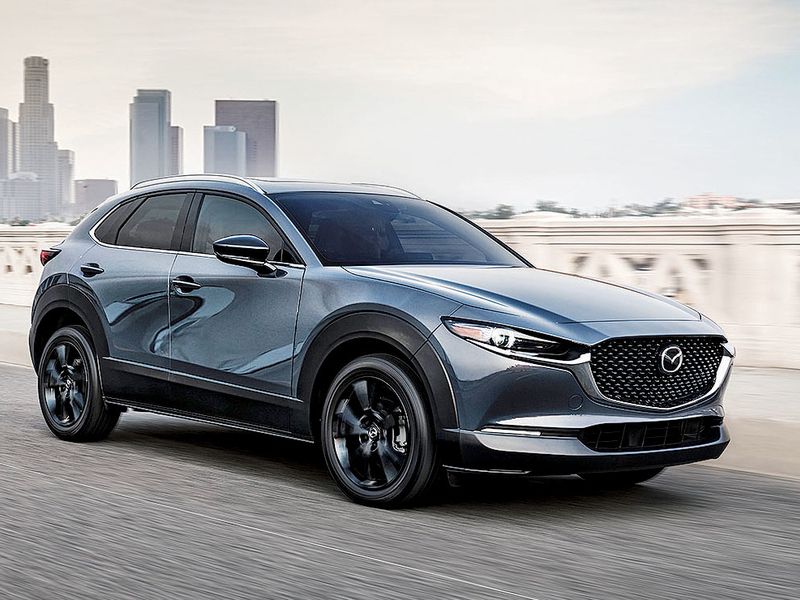
LOS ANGELES — Mazda’s CX-30 subcompact crossover was called on to do some heavy lifting when it was offered for the 2020 model year. Its sales of just more than 38,000 last year kept the automaker in the black, with a 0.2 percent rise in deliveries across its seven-vehicle lineup, despite the pandemic.
But for 2021, the CX-30 has an even bigger challenge: to take on brands such as BMW, Audi and Mercedes-Benz in the small-crossover segment where labels still mean a lot.
Mazda engineers have armed the CX-30 with a new turbocharged engine, all-wheel drive and an upscale interior for the heavy lift.
The CX-30 2.5 Turbo, launched last month, is Mazda’s strongest play yet as it seeks to move the brand upmarket without losing its mainstream buyers. The crossover sits on a new platform, with new infotainment software, high-end materials such as red leather and a full standard safety suite.
“We know the CX-30 has had great success in its current positioning, but with the addition of the turbo engine and the additional power, that really does allow it to compete versus the small SUVs in the premium zone,” said Kingsley Iduma, manager of vehicle planning and strategy at Mazda North American Operations. “The turbo is the next step in Mazda’s path to premium.”
The Mazda3 2.5 Turbo sedan and hatchback, which went on sale as 2021 models, also have more power and exclusive trim levels to set them apart from their non-turbo siblings. And they are targeting shoppers for premium brands.
But the CX-30 Turbo will having a much bigger audience: the growing market for young, urban buyers who aspire to an adventurous lifestyle outside of the city on weekends.
Last year, the CX-30 outsold the Mazda3 — a much more established model — for the No. 2 sales spot in the lineup.
Mazda product planners relish the opportunity to make the case for the CX-30 Turbo over German and Asian premium models. The pitch includes Mazda’s sensuous styling, careful suspension tuning for on-road and off-road, a finely crafted interior and an engine that makes 250 hp on premium gasoline.
The price is critical, too. Compared with the near-luxury competitors it’s targeting for the first time, the model is a bargain. At $31,225, including shipping, for the entry turbo model, the upscale CX-30 is several thousand dollars less than premium crossovers of a similar size.
“I honestly feel that this turbo engine makes this car clearly stand out, even among the high-dollar premium competitors,” said Jay Chen, manager of powertrain performance at Mazda North American Operations. “It has better specs and more importantly, it offers a more consistent, predictable and engaging driving experience across a broad range of uses,” Chen said during a product presentation.
Iduma said the CX-30 has more power and a similar feature set compared with premium-segment small crossovers such as the BMW X1, Mercede-Benz GLA and Audi Q3. But the price difference can be as much as $6,000.
The question facing Mazda is whether premium buyers will consider a value proposition — which could tip the scales toward the new CX-30 Turbo.
“It’s an interesting new tactic in Mazda’s effort to put a ‘premium’ spin on its brand,” said Karl Brauer, executive publisher at CarExpert.com. “It’s difficult to move a brand upmarket after a having a long history of non-luxe status, and offering non-luxe versions of the same model makes it an even tougher sale for traditional luxury shoppers.”
Brauer asks: Would an Audi shopper feel comfortable with the premium status of a fully loaded turbo trim, knowing that Mazda’s basic CX-30 has a starting price of $23,225 with shipping? Buyers will consider more than the quality of the interiors or the performance of the drivetrain. The ownership and dealer experience will also be a factor, he added.
It will take more than a well-engineered and aggressively priced CX-30 Turbo for Mazda to inch from mainstream to premium, Bauer said.
“This is a long process that requires commitment, along with wise product development and pricing strategies,” Brauer said.
That’s a heavy lift indeed.

